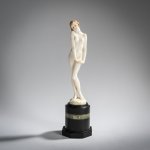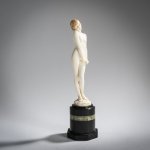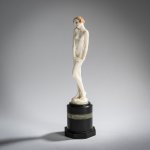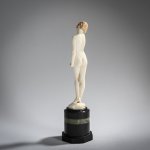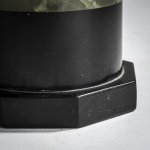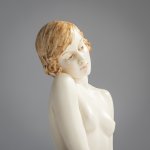Lot: 693
Ferdinand Preiss
'Coyness', 1920s
H. 20,1 cm, H. 27.6 cm (with base). Carved ivory, partially painted. Plinth and base signed: F. Preiss (engraved). Composite base made of black marble and onyx. Also signed: F. Preiss.
Retouching on the right ankle down to the natural base.
Hammer Price: 9,000 €
04. December 2024 at 4:00 PM CET
Literature:
Johann Philipp Ferdinand Preiss began his training in the ivory carving workshop of his uncle Philip Willmann. After graduating, he stayed at his workshop for a few years and also continued his education at the newly founded vocational school in Erbach. Travels and study visits took him to Berlin, Milan and Paris, among others. In 1907, he briefly worked in Karl Haebler's company in Baden-Baden, where he met his future partner Arthur Kassler. Together they founded the company 'Preiss & Kassler Workshop for Ivory and Art' in Berlin. With at least six employees, they made sculptures, small objects and jewelry from ivory. Kassler took care of the finances while Preiss took over the artistic direction of the workshop from the start. Soon he began to revive the ancient technique of chryselephantine (Chrys = gold; elephantinos = made of ivory). Until the First World War, when the workshop had to be temporarily closed, Preiss & Kassler had great success at home and abroad with these figures, which at the time still paid homage to the classical style. He received the bronze parts for it from the well-known Berlin foundry H. Gladenbeck & Son. After the end of the war, there were initially difficulties to get material for figurines, but Preiss succeeded with a new style to depict the full life of the now 'Roaring Twenties' and thus re-kindled the interest of customers in Germany and in the rest of the world. The "Shyness" figurine offered here is a wonderful example of the transition phase. Shayo, Ferdinand Preiss, Woodbridge 2005, p. 90.
An EC certificate has been issued for this lot by the Department for Climate and Environmental Protection of the City of Munich, which allows objects with ivory to be marketed within the European Union.
Read our Terms & Conditions.







